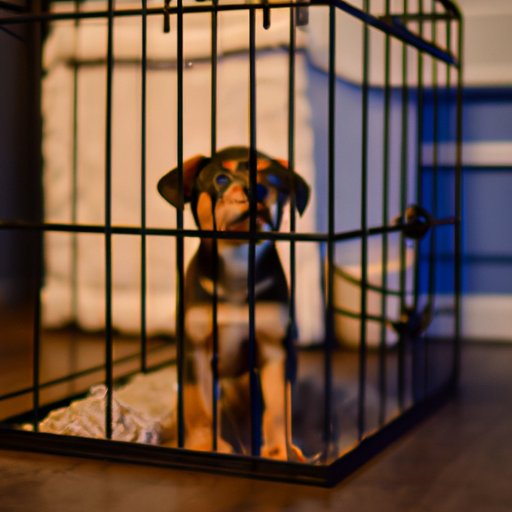
Introduction
Crate training your puppy at night can be a daunting task, but it’s essential for their well-being and your peaceful sleep. In this article, we will provide a comprehensive guide on how to crate train your puppy at night successfully. We’ll go over what crate training is, common myths and misconceptions, and five best practices to keep in mind. We’ll also offer practical tips on making crate training a positive experience and transitioning to nighttime crate training. Lastly, we’ll provide you with a step-by-step guide and emphasize the importance of routine in successful crate training.
The Complete Guide to Crate Training Your Puppy at Night
Crate training is a process of teaching your puppy to accept and use a crate as their safe space. It provides them with a sense of comfort and security, and it helps prevent behavior problems like destructive chewing, separation anxiety, and house soiling. When choosing a crate, there are several types available, including plastic, wire, and soft-sided crates. The crate you choose should be the right size for your puppy, allowing them to stand up, turn around, and lie down comfortably.
There are some common misconceptions about crate training, such as it’s cruel or that it’s equivalent to putting your puppy in jail. However, crates serve as a natural den for dogs and are where they instinctively seek refuge. Furthermore, dogs won’t feel trapped inside of a crate as long as they associate it with positive experiences and voluntary confinement.
5 Best Practices for Successful Puppy Crate Training
For successful crate training, you should keep in mind five key principles. Firstly, consistency is essential; be consistent with the crate’s location, routine, and commands. Secondly, show patience and avoid punishing your puppy. The third principle is being positive, provide rewards for good behavior and avoid negative reinforcement. Fourthly, introduce your puppy to crate training gradually, and lastly, avoid overuse of the crate.
For instance, when you introduce your puppy to the crate, start by making their crate comfortable, and place their toys and treats inside. Also, place the crate in an area where the puppy can see and hear their family. Gradually increase the time your puppy spends in the crate, but avoid leaving them in the crate for extended periods.
How to Make Crate Training a Positive and Calming Experience for Your Puppy
To make crate training a positive and calming experience for your puppy, you can try different things such as creating a relaxed atmosphere, providing calming scents, and playing soothing music. It’s also essential to reinforce positive behavior, such as when they enter the crate voluntarily or when they remain calm in the crate. You can provide treats, verbal praise, or even a special toy to associate with the positive experience in the crate.
Nighttime Crate Training: Tips for a Restful and Successful Transition
Crate training a puppy at night can be challenging, but it’s possible with some tips and tricks. When transitioning from daytime to nighttime crate training, start by having your puppy take short naps in the crate during the day. It’s also essential to tire your puppy out before bedtime with some exercise. You can also use crate games or install puzzle toys to keep your puppy’s mind stimulated. When it’s time to sleep, give your puppy a calming treat and gradually increase the crate’s duration. If your puppy cries in the night, avoid ignoring or punishing them; instead, take them outside to relieve themselves and offer support and reassurance before returning them to the crate.
Step-by-Step Guide on How to Crate Train Your Puppy for Nighttime
Here’s a step-by-step guide you can follow to crate train your puppy for nighttime:
- Start by introducing your puppy to the crate by making it a positive experience through rewards and treats.
- Gradually increase the time your puppy spends in the crate, so they learn to associate the crate with positive experiences and voluntary confinement.
- Introduce the concept of confinement by closing the crate door for a few minutes at a time, while you’re nearby.
- Gradually increase the duration of confinement, and leave the room briefly.
- Repeat step four, but increase the duration you’re away, and remain calm when leaving and returning.
- Start to enforce the routine, such as a pre-bedtime walk and a calming routine before they sleep.
- Ensure the crate is the right size and provides enough comfort, avoid adding too many toys or blankets.
The Importance of Routine in Crate Training Your Puppy at Night
The importance of routine in successful crate training can’t be overstated. Creating a routine can create a sense of security and comfort for your puppy, signaling the beginning and end of a particular activity or time of day. Your puppy will soon learn that when they wake up, it’s time to go outside, and when it’s nighttime, it’s time to sleep in the crate.
Conclusion
Crate training your puppy at night can be challenging, but it’s essential for their health and your peaceful sleep. Remember to be consistent, patient, positive, and gradually introduce the crate to your puppy. Provide a calming atmosphere, use positive reinforcement, and establish a routine. With time and dedication, your puppy will learn to love their crate and see it as their safe haven.
To learn more about crate training and puppy care, you can find a wealth of resources online, including YouTube videos and blogs.





